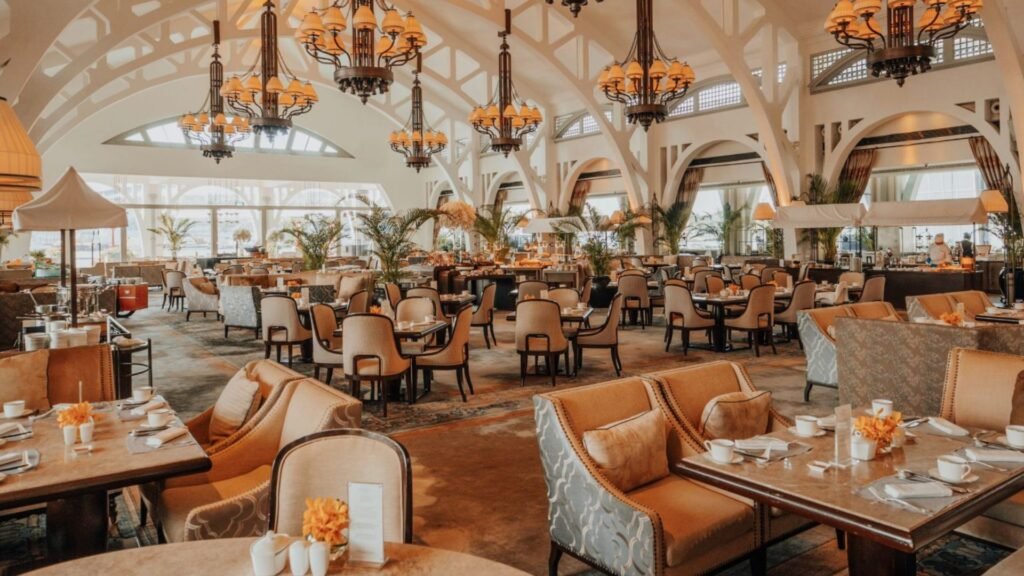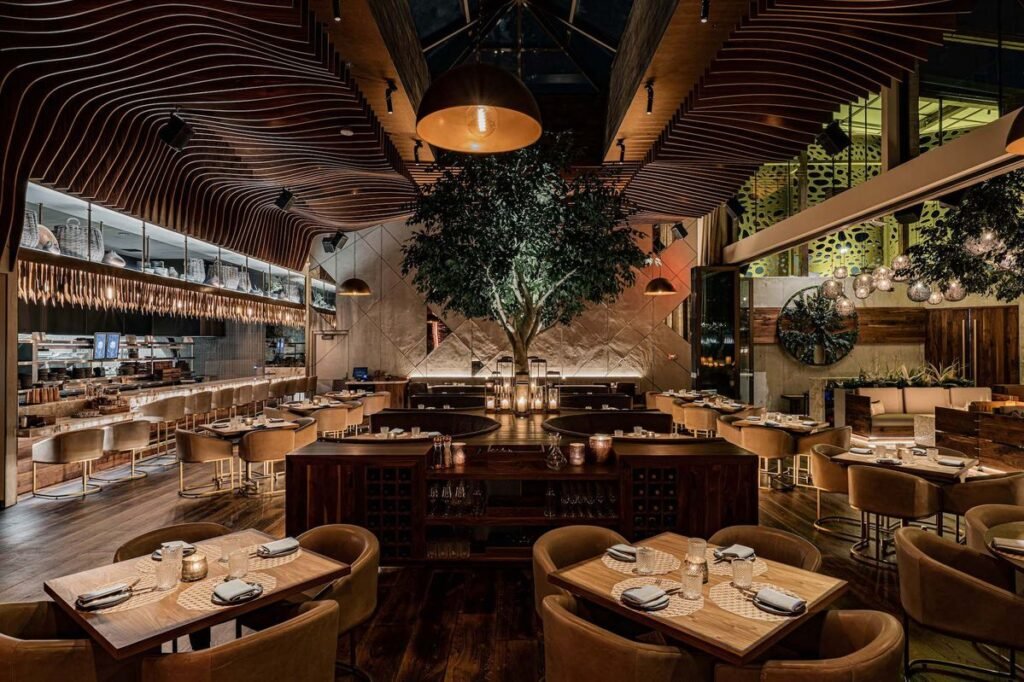Meta Description:
Explore Fine Dining Restaurant Interiors tailored for hotel restaurants and dining—expert design ideas and luxury interiors to elevate every culinary experience.

Introduction
Fine Dining Restaurant Interiors aren’t just about design—they’re about theatre, emotion, and storytelling. In the world of luxury hotels, dining is no longer confined to the plate. Guests crave experiences that seduce the senses the moment they walk in. The scent of polished wood, the shimmer of candlelight on marble, the hush of velvet-draped corners—these details define not just a meal, but a memory. At Good House Interiors, we don’t just design hotel restaurants—we compose atmospheres where culinary excellence meets architectural grace. Whether it’s a sophisticated buffet, a themed gastronomic escape, or a starlit patio, every element deserves intention. Let’s uncover what transforms hotel dining into art.
Setting the Stage: The Power of Design in Hotel Restaurants
Designing interiors for hotel restaurants is about crafting emotion through space. Guests don’t just come to eat—they arrive expecting an experience. Whether it’s a destination for fine cuisine or an all-day dining venue, hotel restaurants and dining spaces must blend style with purpose.
Why It Matters
- Dining spaces act as brand ambassadors for luxury hotels.
- Guests often judge the quality of a hotel by its restaurant interiors.
- Memorable interiors enhance word-of-mouth, reviews, and return visits.
Fine Dining Restaurant Interiors: Designing for Experience
Embracing Modern Decor with Timeless Elegance
At the heart of fine dining is subtle sophistication. Modern decor in today’s luxury restaurants involves sleek lines, tactile richness, and thoughtful contrasts—think warm walnut walls paired with brushed gold lighting, or sculptural furniture in neutral palettes that allow culinary presentation to shine.
- High-end textiles like velvet, boucle, and leather for seating
- Accent lighting designed to flatter dishes and diners alike
- Layered textures: stone, glass, wood, and fabric used with restraint
Spatial Rhythm and Flow
Great interiors support seamless service and effortless guest movement. The design should anticipate the rhythm of the restaurant, from morning espresso to midnight tastings. A fine dining space is choreographed—tables spaced for privacy, waitstaff paths optimized, and sightlines maintained.
Themed Restaurant Concepts: Dining as Destination
Whether inspired by global flavors or historical periods, themed restaurant concepts turn a meal into a voyage. A design rooted in authenticity and imagination invites guests to escape the ordinary.
Examples of strong themed concepts:
- Japanese Minimalism: Shou sugi ban walls, tatami textures, low seating, lanterns
- Parisian Elegance: Gilded mirrors, crystal sconces, black-and-white tile mosaics
- Moroccan Chic: Hand-carved arches, jewel-toned fabrics, bronze lantern clusters
The trick is restraint. Themes should feel curated—not theatrical. Let materials, color, and lighting whisper the story instead of shouting it.
Buffet and All-Day Dining Spaces: Elegance in Versatility
Buffet dining doesn’t mean compromising on luxury. With smart planning, all-day dining venues can still feel exclusive, comfortable, and refined.
Stylish Upgrades for Buffets
- Curved buffet counters with seamless solid surfaces for hygiene and grace
- Open kitchen areas with glass partitions for live culinary theatre
- Ceiling-hung signs or sculptural lighting elements to define food zones
A palette of soft neutrals punctuated with greenery or abstract art can keep the space lively without overwhelming the senses—ideal for guests at any time of day.
Outdoor Dining and Patio Areas: Al Fresco, Reimagined
There’s something magical about dining under the sky. Whether it’s a sun-drenched terrace or an evening under the stars, outdoor dining and patio areas elevate the guest experience when designed with intention.
Design Ideas for Outdoor Dining:
- Pergolas with retractable roofs or flowing drapes for shade and privacy
- Stone-topped tables and plush seating in water- and UV-resistant finishes
- Fire pits, statement planters, or water features for ambiance
Lighting is crucial—use indirect LEDs along pathways, pendant fixtures above dining zones, and flickering candles on tables to set a tranquil mood.
Signature Touches That Define Fine Dining Interiors
A true luxury dining space is more than the sum of its parts. What sets the design apart is the detail—the designer touches that make the guest pause, admire, and remember.
These could include:
- A custom-made host station in travertine or sculpted wood
- A feature wall made of hand-applied Venetian plaster or mirrored mosaic
- Elegant partition screens that offer privacy while enhancing the visual rhythm
At Good House Interiors, we integrate these moments of beauty without interrupting functionality. It’s about designing restaurants that work beautifully—visually and operationally.
Conclusion
Exceptional Fine Dining Restaurant Interiors require more than beautiful furniture and fashionable finishes. They demand deep understanding—of brand story, guest psychology, and spatial choreography. Whether you’re revamping a hotel’s existing restaurant or launching a fresh culinary concept, your design should evoke luxury at every glance and gesture. Good House Interiors invites you to create dining spaces that dazzle guests and stand the test of time. Contact us today for bespoke space planning, custom furniture, and refined luxury interiors tailored for your hotel.
Frequently Asked Questions (FAQs)
Q1: What defines a fine dining restaurant interior in a hotel setting?
A: It’s a curated blend of elegance, comfort, and functionality—featuring high-end finishes, atmospheric lighting, and seamless layouts that support fine service and guest experience.
Q2: How do buffet restaurants maintain a luxury look?
A: Through elegant materials, cohesive color schemes, and well-integrated food stations that blend with the overall interior, rather than standing out as utilitarian elements.
Q3: What’s the best way to incorporate themed design in hotel restaurants?
A: Use authentic materials, subtle storytelling, and immersive design features that reflect the theme without feeling staged or gimmicky.
Q4: Why is lighting so important in fine dining design?
A: Lighting affects ambiance, food presentation, and guest comfort. Layered lighting—including ambient, accent, and task sources—creates a dynamic, flattering environment.
Q5: Can outdoor dining areas truly feel luxurious?
A: Absolutely—with high-end outdoor furnishings, mood lighting, and thoughtful landscaping or architectural features, outdoor dining can rival any interior experience.

مقدمة
تصميم المطاعم الفاخرة لا يقتصر على الجمال البصري—بل هو عرض مسرحي، عاطفة، وحكاية تُروى من خلال التفاصيل. في عالم الفنادق الفاخرة، لم تعد تجربة تناول الطعام محصورة في الأطباق فقط. الضيوف يبحثون عن لحظات ساحرة تُخاطب حواسهم منذ دخولهم المطعم. رائحة الخشب المصقول، انعكاس الشموع على الرخام، وهدوء الزوايا المغطاة بالمخمل—كل هذه التفاصيل تُكوّن ذكرى لا تُنسى. في Good House Interiors، لا نُصمم فقط المساحات، بل نُبدع أجواء تلتقي فيها روعة الطهي بجمال التصميم. سواء كانت صالة بوفيه أنيقة، أو مطعماً بموضوع خاص، أو جلسة خارجية تحت النجوم، فإن كل عنصر يستحق لمسة متقنة. فلنكتشف كيف يتحول تناول الطعام في الفنادق إلى فن حقيقي.
تحديد المشهد: قوة التصميم في مطاعم الفنادق
تصميم ديكور مطاعم الفنادق هو فن يُترجم المشاعر إلى مساحات. فالضيوف لا يأتون فقط لتناول الطعام، بل يبحثون عن تجربة متكاملة. سواء كان مطعمًا راقيًا أو مكانًا لتناول الطعام طوال اليوم، يجب أن تدمج المساحة بين الأناقة والعملية.
لماذا يعتبر التصميم عنصرًا مهمًا؟
- مساحات تناول الطعام تعكس هوية الفندق الفاخرة.
- غالبًا ما يُقيّم الضيوف جودة الفندق من خلال تصميم مطاعمه.
- التصاميم المميزة تعزز التقييمات الإيجابية وتكرار الزيارات.
تصميم مطاعم فاخرة: خلق تجربة متكاملة
دمج الديكور العصري مع الفخامة الكلاسيكية
يعتمد تصميم مطاعم فاخرة على مزيج متناغم من الديكور العصري والأناقة الخالدة. الخطوط النظيفة، المواد الفاخرة، والتفاصيل الدقيقة—مثل الجدران الخشبية الغنية، الإضاءة الذهبية الناعمة، والمفروشات النحتية—تخلق بيئة جذابة دون إرباك الضيف.
- أقمشة فاخرة مثل المخمل والجلد في المقاعد.
- إضاءة مدروسة تُبرز الطعام وتُجمل ملامح الضيوف.
- استخدام الأحجار، الزجاج، والخشب بتوازن مثالي.
انسيابية التصميم الداخلي
يجب أن يُسهل التصميم الجيد حركة الضيوف والخدمة على حد سواء. من لحظة دخولهم إلى الجلوس ثم المغادرة، يجب أن تسير التجربة بسلاسة، مع توزيع الطاولات بشكل يوفر الخصوصية ويحافظ على الانسيابية البصرية.
مفاهيم المطاعم ذات الطابع الخاص: تناول الطعام كرحلة
سواء استُوحي المفهوم من ثقافات عالمية أو فترات تاريخية، فإن تصميم مطاعم بطابع خاص يمكن أن يُحول تجربة تناول الطعام إلى مغامرة حسية.
أمثلة على مفاهيم تصميم مبتكرة:
- اليابانية البسيطة: جدران محروقة (Shou Sugi Ban)، إضاءة الفوانيس، أرضيات تاتامي.
- الأناقة الباريسية: مرايا مطلية بالذهب، ثريات كريستالية، أرضيات من البلاط الأبيض والأسود.
- الأسلوب المغربي: أقواس منقوشة يدويًا، أقمشة زاهية، فوانيس نحاسية.
النجاح يكمن في التوازن—يجب أن تكون الفكرة محسوسة، دون أن تكون مسرحية أو مبالغ فيها.
بوفيهات ومساحات تناول الطعام طوال اليوم: الأناقة الوظيفية
المرونة لا تعني التنازل عن الرقي. يمكن لتصميم مطاعم البوفيه أن يبقى أنيقًا مع الحفاظ على العملية، عبر تقسيم المساحات بذكاء واستخدام المواد الفاخرة.
تحديثات أنيقة لمساحات البوفيه:
- محطات تقديم طعام منحنية بسطح موحد وسلس لسهولة التنظيف.
- مطابخ مفتوحة خلف زجاج شفّاف لإضافة عامل عرض حي.
- توزيع المقاعد بين الكبائن والطاولات المفتوحة لتوفير خيارات متنوعة.
مساحات تناول الطعام الخارجية: رفاهية الهواء الطلق
يُفضل العديد من الضيوف تناول الطعام في الهواء الطلق، لا سيما إذا كانت البيئة مصممة بذوق. يمكن لـجلسات الباحات أن تتحول إلى وجهات بحد ذاتها من خلال التفاصيل المدروسة.
أفكار تصميمية للمساحات الخارجية:
- هياكل مظللة قابلة للسحب مع ستائر خفيفة تضيف خصوصية.
- مفروشات مقاومة للعوامل الجوية مع وسائد فاخرة.
- عناصر ديكور مثل الشلالات، الأشجار الرأسية، أو النيران المكشوفة.
تلعب الإضاءة دورًا رئيسيًا هنا—يمكن استخدام أضواء خافتة مدمجة، فوانيس معلقة، أو شموع لإضفاء أجواء ساحرة.
اللمسات النهائية: ما يميز Good House Interiors
في Good House Interiors، لا نُقدم تصميمات جميلة فقط، بل نُقدم حلولاً ذكية تُراعي التشغيل اليومي، الراحة، وانسيابية الخدمة. نُصمم بالشراكة مع الطهاة ومديري الفنادق، لخلق مساحات متناغمة من المطبخ إلى الطاولة.
- تخطيط ذكي للمساحة لضمان تجربة سلسة للضيوف والعاملين.
- أثاث مخصص يعكس هوية العلامة التجارية.
- تصميم إضاءة يتغير بانسيابية بين أوقات الخدمة المختلفة.
كل مشروع نقوم به هو انعكاس لرؤية فريدة، تُترجم إلى تصميم لا يُنسى.
الخاتمة
تصميم مطاعم فاخرة داخل الفنادق ليس مجرد وظيفة جمالية، بل هو علم وفن يُعبر عن العلامة التجارية ويُثري تجربة الضيف. من الألوان والأثاث إلى الإضاءة والتخطيط، كل عنصر يلعب دورًا. إذا كنتم تستعدون لإطلاق أو تجديد مطعم راقٍ في فندقكم، تواصلوا مع Good House Interiors لنُصمم لكم مساحات استثنائية تعكس الفخامة في كل تفصيل—من تخطيط المساحات إلى الأثاث المخصص والديكورات الراقية.
الأسئلة الشائعة
ما الذي يُميز تصميم المطاعم الفاخرة داخل الفنادق؟
يعتمد على استخدام خامات راقية، توزيع مدروس للمساحة، إضاءة جوية، وأثاث أنيق يُعزز التجربة بأكملها.
كيف نحافظ على الفخامة في مطاعم البوفيه؟
من خلال استخدام مواد فاخرة، تنسيق لوني موحد، ومحطات تقديم أنيقة مدمجة بسلاسة في التصميم العام.
هل تصميم المطاعم ذات الطابع يستحق الاستثمار؟
بالتأكيد، حيث يخلق تجربة فريدة ويعزز هوية المكان بشرط أن يتم تنفيذها بذوق ورؤية واضحة.
لماذا الإضاءة مهمة في تصميم المطاعم؟
لأنها تؤثر على المزاج، وضوح الأطعمة، وراحة الضيوف. الإضاءة الموزعة بطريقة مدروسة تخلق أجواء لا تُنسى.
هل يمكن أن تكون جلسات الهواء الطلق فاخرة؟
نعم، باستخدام أثاث خارجي راقٍ، إضاءة مناسبة، وتصميم محيط جذاب، تصبح تجربة الهواء الطلق مساوية لتجربة الداخل بل وأفضل أحيانًا.
